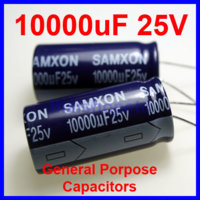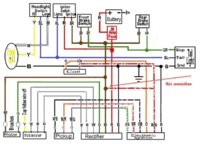hi folks, I have yet another question about the red/white wire that comes off the stock ignition box, using that 2nd diagram in this thread, in a colorized version I showed above (and have attached below).
That red/white wire has to make a "T". One branch goes to the coil and one attaches to the brown wire.
The thing that is confusing me: doesn't the fact that that wire goes to coil from IG. box mean that the coil gets some kind of "info"
from the ignition? That has to do with timing? So if it is attached to that brown wire TOO (as in the diagram), isn't the coil getting
constant power then, with key on, just by virtue of the red/white wire being T'ed into the brown wire prior to being attached to coil?
Could in theory with this diagram, the red/white wire, the brown wire and the coil wire (not the orange one, the one that attaches to red/white) just all 3 be twisted together?
I'm not understanding what the brown wire does for the red/white wire and coil. If it is simply powering the coil, then why go to the ignition at all?
Again, my thought is the ignition is powering on and off with the timing, so the coil knows when to fire. But how can it do that, if it is tied directly into that brown wire as the diagram shows?
Or maybe I'm misunderstanding, and all the brow wire is doing is supplying power to coil and to Ignition box? If that's the case, couldn't I run a shorter wire to the coil, if all it needs is power from the brown wire?
Like, INSTEAD of the coil getting power via this circuitous route, down to ignition box and then back up to coil under gas tank.... couldn't I just provide a "T" off the brown wire, closer to the key switch?
I understand the brown wire pretty well in some ways (thanks to the efforts of several of you) but I'm just not sure about the red/white wire on IG and the brown wire. Is brown wire just "feeding" Ignition box power? or is red/white wire also providing electrical "info" to coil, re: timing?
sorry to be so dumb, but I really have pondered this a lot today.
It seems so simple, and yet....


Making an intelligent connection between red/white wire on IG, brown wire, and wire to coil (as in this diagram) is baffling me. Could those 3 wires just be twisted together? or must they be "t'ed" in some certain order?
ps: I'm not going to just twist them together, but I just want to know if , in essence, that is what is being accomplished by wiring as in the diagram.
thx!








